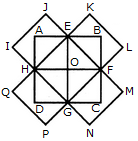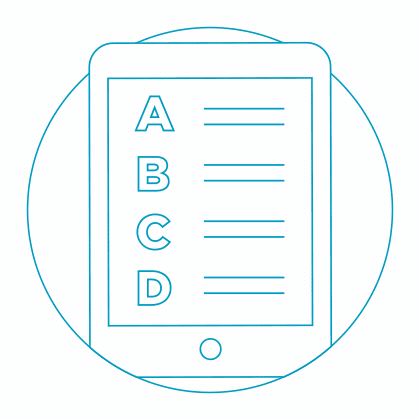REASONING - Online Test
Count the number of parallelogram in the given figure.

The figure may be labelled as shown.

The simplest parallelograms are LMHJ and BDFM i.e. 2 in number. The parallelograms composed of two components each are ABML and MFGH i.e. 2 in number.
The parallelograms composed of three components each are LBHI, LBEF, BDGH, DFLA, BCFH, KLFH, A6HJ and LFGJ i.e. 8 in number.
The parallelograms composed of six components each are LCFI, KBEH and ADGJ i.e. 3 in number.
Total number of parallelograms in the figure = 2 + 2 + 8 + 3 = 15.
Consider the following information regarding the performance of a class of 1000
students in four different tests:
| Tests | I | II | III | IV |
| Average marks | 60 | 60 | 70 | 80 |
| Range of marks | 30 to 90 | 45 to 75 | 20 to 100 | 0 to 100 |
If a student scores 74 marks in each of the four tests, in which one of the following tests is her performance the best comparatively?
Count the number of convex pentagons in the adjoining figure.

A convex pentagon has no angles pointing inwards. More precisely, no internal angles can be more than 180°.
The figure may be labelled as shown.

The pentagons in the figure, are ABDFH, CDFHB, EFHBD, GHBDF, ACDFG, CEFHA, EGHBC, GABDE, BDEGH, DFGAB, FHACD and HBCEF. Clearly, these are 12 in number.
Three persons A, B and C wore shirts of black, blue and orange colours (not necessarily in that order) and pants of green, yellow and orange colours (not necessarily in that order). No persons were shirt and pants of the same colour. Further it is given that
- A did not wear shirt of black colour.
- B did not wear shirt of blue colour.
- C did not wear shirt of orange colour.
- A did not wear pants of green colour.
- B were pants of orange colour.
What were the colours of the pants and shirt were by C respectively?
Count the number of rectangles in the given figure.

The figure may be labelled as shown.

The rectangles composed of two components each are HIJE, EKJ,F, FMNG, GPQH, AEOH, EBFO, OFCG and HOGD i.e. 8 in number.
The rectangles composed of four components each are ABFH, BCGE, CDHF, DAEG and EFGH i.e. 5 in number.
The rectangles composed of six components each are IJFG, KLGH, MNHE and PQEF i.e. 4 in number.
The rectangles composed of eight components each are IJMN, KLPQ and ABCD i.e. 3 in number.
Thus, there are 8 + 5 + 4 + 3 = 20 rectangles in the given figure.
(Here note that the squares are also counted amongst rectangles)
